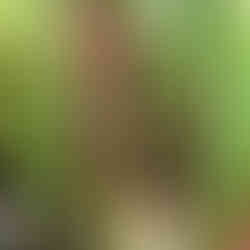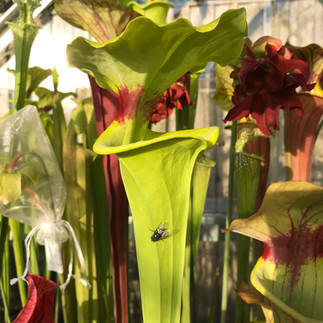How to Care for Sarracenia
- Megan
- Oct 5, 2022
- 4 min read

Sarracenia, commonly known as the North American Pitcher Plant, is a striking carnivorous plant which consist of a series of hollow pitchers growing from a central rhizome which can capture an abundance of insects. They are simple and easy to grow as well as one of the most fun and rewarding plants you can grow; however, they are widely overlooked. Personally, I think Sarracenia are my second favourite genus within the carnivorous plant next to Drosera.
They are herbaceous perennials, which as their common name suggests, are native to Northern America, mostly in the South-eastern coastal plain. The climate of which is warm and humid during the summer and winters are cool with occasional frosts. However, in recent years, Sarracenia populations have been lost due to habitat loss thus causing several species to become endangered.
There are 8 species of Sarracenia, categorised by alata, flava, leucophylla, minor, rubra, purpurea, psittacina and oreophila. All Sarracenia will flower, often producing a long flower stalk which can reach up to 3ft high and the flowers will open before the plant produces its first pitcher in order to prevent capturing pollinators!
The Sarracenia flower is definitely unique in the Horticultural world but easy to pollinate, providing the grower with hundreds of seeds which can create some unique new plants!
Once pollinated the petals will drop and the ovary will swell and remain there all summer until around October time when the weather cools down, the seed pods will then ripen, turn brown and start to crack revealing seeds inside!
Below I will set out a simple guide on how to grow Sarracenia and what has worked well for me!
Lighting:
These plants require a lot of light which allows the pitchers to stand upright and produce deeper colouration. Outdoors or in an unheated greenhouse is the best place for them. However, they can be grown inside under high intensity grow lights or on the sunniest windowsill if you do not have access to an outdoor space.
Watering:
The best method for watering is the tray method and have them sit in about an inch of water from Spring until late Autumn before dormancy. During dormancy watering should be reduced but never let them dry out, they should remain damp.
Media:
For my Sarracenia I use a mix of 2:1 peat and perlite. Long fibred sphagnum moss also works well. Recently I have been trialing several mixes using bark and Sarracenia so far have responded well to peat reduced trials.
Dormancy:

These plants require a cold period in which temperatures are below 10C for an extended period of time often between Halloween and Valentine's day, if kept outside then you will naturally see the plants slow when the temperature drops and there is a reduced photo-period (from around the end of September) The plants will die down to their rhizomes and will often create phyllodia (a non-carnivorous leaf) in winter to allow the plant to photosynthesis during the cooler months.
This is the perfect time to repot or divide. Sarracenia can survive in temperatures below 0C, and a dormancy period is recommended to ensure healthy plants.

(Left) One of my outdoor bog barrels, frozen and covered in snow. You can see the Sarracenia purpurea in which has several pitchers on due to its hardiness I find it doesn't lose all its pitchers. Then at the back, two Sarracenia flava varieties of which have phyllodia. Both flava and purpurea are perfect to be outside year-round and very hardy!
‘Indigestion’: If your plants have been in an outside/greenhouse space then it is likely they will have devoured masses of insects during the growing period which often leads to holes and browning pitchers at the beginning of autumn. Almost like indigestion, you will often find the pitcher is filled to the top with flies, wasps and beetles. This is nothing to worry about and naturally occurs, cut off any dead pitchers from the base of the plant.
Feeding:
Sarracenia are greedy plants and will eat and abundance of insects if able. However, if you cannot provide an outdoor space or place your plant in a space which has abundance of insects then they can be fed flies, crickets or even dried insects.
Pitchers:
All Sarracenia except Sarracenia purpurea will produce digestive enzymes to break down and digest insects. Sarracenia purpurea are wonderful candidates for outdoor bog gardens as the pitchers will naturally fill with rainwater and are extremely hardy in low temperatures. If you have a Sarracenia purpurea indoors then you can fill the pitchers with a little bit of rainwater.
Flowers:
A mature Sarracenia will flower in Spring; this is one of the first signs of growth you will see from your plant if it flowers. Unlike flytraps, flowering will not harm a Sarracenia and therefore if you would like to collect seeds then you can let your flower. If you have multiple plants flowering, then you can create several hybrids. Once the petals drop, a fat pod should be left behind indicating success, the flower pod will remain for 3-4 months before it is ready to harvest.
(Above) Sarracenia flower stalks emerging in Spring and a few different flowers

(Left) A ripened seed pod ready for harvest!
Look how many seeds you get from just one seed pod!
Some more Sarracenia highlights from my collection earlier in the year:
What I love the most about Sarracenia is that there is now so many hybrids due to breeding between growers, they are all unique and stunning in their own way and if you build up a collection yourself then you can be the ones creating the hybrids. Rasing these plants from seed that you have pollinated is the best feeling when you create something beautiful!


















































Comments